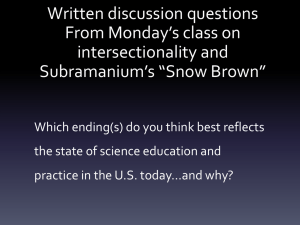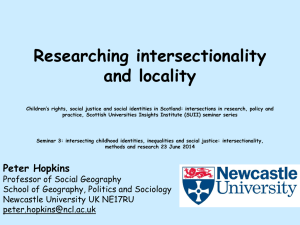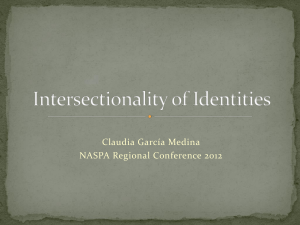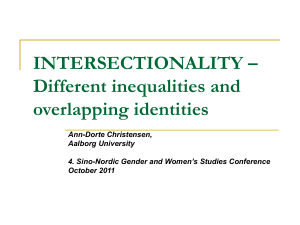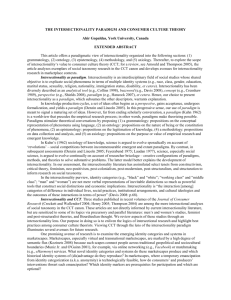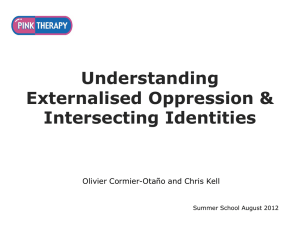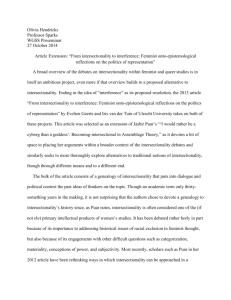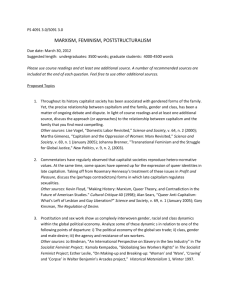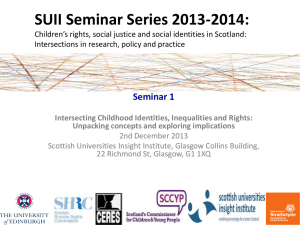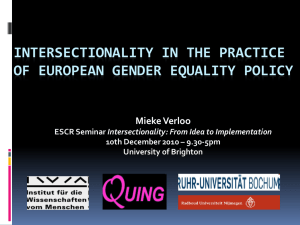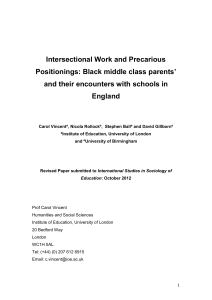Centre for Human Rights and Legal Pluralism Faculty of Law, McGill
advertisement
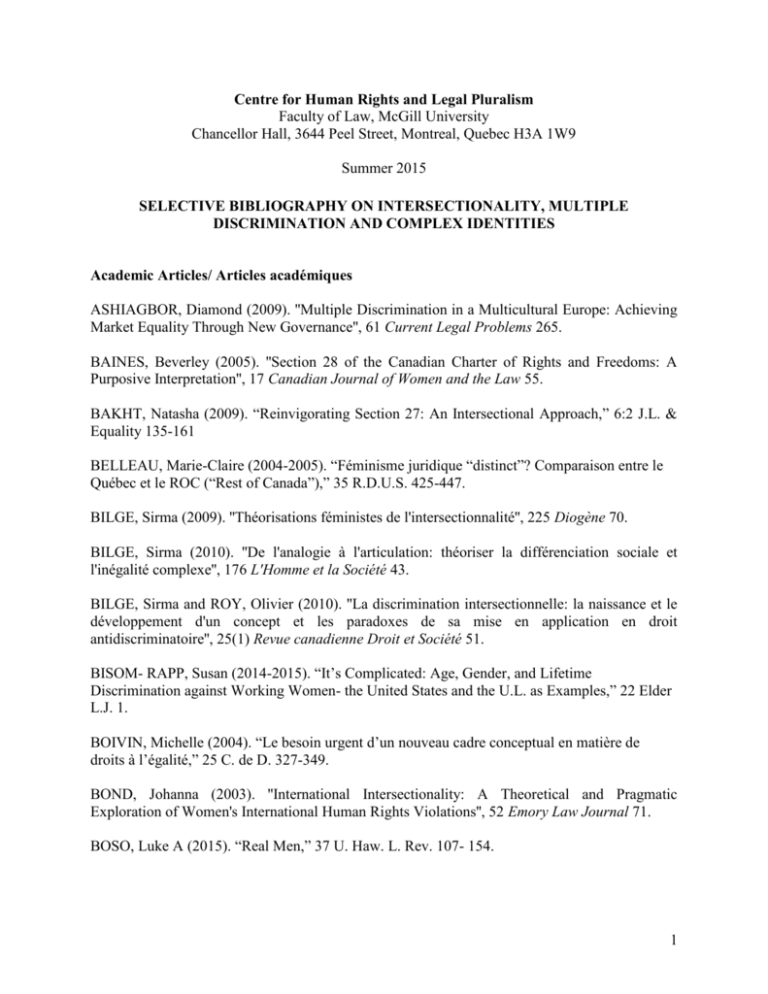
Centre for Human Rights and Legal Pluralism Faculty of Law, McGill University Chancellor Hall, 3644 Peel Street, Montreal, Quebec H3A 1W9 Summer 2015 SELECTIVE BIBLIOGRAPHY ON INTERSECTIONALITY, MULTIPLE DISCRIMINATION AND COMPLEX IDENTITIES Academic Articles/ Articles académiques ASHIAGBOR, Diamond (2009). ''Multiple Discrimination in a Multicultural Europe: Achieving Market Equality Through New Governance'', 61 Current Legal Problems 265. BAINES, Beverley (2005). ''Section 28 of the Canadian Charter of Rights and Freedoms: A Purposive Interpretation'', 17 Canadian Journal of Women and the Law 55. BAKHT, Natasha (2009). “Reinvigorating Section 27: An Intersectional Approach,” 6:2 J.L. & Equality 135-161 BELLEAU, Marie-Claire (2004-2005). “Féminisme juridique “distinct”? Comparaison entre le Québec et le ROC (“Rest of Canada”),” 35 R.D.U.S. 425-447. BILGE, Sirma (2009). ''Théorisations féministes de l'intersectionnalité'', 225 Diogène 70. BILGE, Sirma (2010). ''De l'analogie à l'articulation: théoriser la différenciation sociale et l'inégalité complexe'', 176 L'Homme et la Société 43. BILGE, Sirma and ROY, Olivier (2010). ''La discrimination intersectionnelle: la naissance et le développement d'un concept et les paradoxes de sa mise en application en droit antidiscriminatoire'', 25(1) Revue canadienne Droit et Société 51. BISOM- RAPP, Susan (2014-2015). “It’s Complicated: Age, Gender, and Lifetime Discrimination against Working Women- the United States and the U.L. as Examples,” 22 Elder L.J. 1. BOIVIN, Michelle (2004). “Le besoin urgent d’un nouveau cadre conceptual en matière de droits à l’égalité,” 25 C. de D. 327-349. BOND, Johanna (2003). ''International Intersectionality: A Theoretical and Pragmatic Exploration of Women's International Human Rights Violations'', 52 Emory Law Journal 71. BOSO, Luke A (2015). “Real Men,” 37 U. Haw. L. Rev. 107- 154. 1 BULLOCK, Jess and MASSELOT, Annick (2012-2013). “Multiple Discrimination and Intersectional Disadvantages: Challenges and Opportunities in the European Union Legal Framework,” 19 Colum. J. Eur. L. 57. CARASTATHIS, Anna (2013). “Identity Categories as Potential Coalitions,” 38:4 Signs 941965. CARBADO, Devon and GULATI, Mitu (2001). ''The Fifth Black Woman'', 11 Contemporary Legal Issues 701. CARBADO, Devon W (2013). “Colorblind Intersectionality,” 38:4 Signs 811-845. CHAMALLAS, Martha (2014). “Social Justice Feminism: A New Take On Intersectionality,” 5 Freedom Center J. 11. CHANG, Robert S and MCCRISTAL CULP JR, Jerome (2002). “After Intersectionality,” 71:2 UMKC L. Rev. 485. CHICHA, Marie-Thérèse (2012). ''Discrimination systémique et intersectionnalité: la déqualification des immigrantes à Montréal'', 24(1) Revue Femmes et Droit 82. CHO, Sumi (2013). “Towards a Field of Intersectionality Studies: Theory, Applications, and Praxis,” 38:4 signs 785-810. CHO, Sumi (2014). “Intersectionality and the Third Reconstruction,” 5 Freedom Center J. 21. CLUTTERBUCK, Alyssa (2015). “Rethinking Baker: A Critical Race Feminist Theory of Disability,” 20 Appeal 51-70. CRENSHAW, Kimberlé (1991). ''Mapping the Margins: Intersectionality, Identity Politics, and Violence Against Women of Color'', 43(6) Stanford Law Review 1241. DECKHA, Maneesha (2004). “Is Culture Taboo? Feminism, Intersectionality, and Culture Talk in Law,” 16 Can. J. Women & L. 14. DECKHA, Maneesha (2008). “Intersectionality and Posthumanist Visions of Equality,” 23 Wis. J. L. Gender, & Soc’y 249. DELGADO, Richard (2011). “Rodrigo’s Reconsideration: Intersectionality and the Future of Critical Race Theory,” 96 Iowa L. Rev. 1247. DEVLIN, Richard F and SHERRARD, Matthew (2005). “The Big Chill?: Contextual Judgment after R. v. Hamilton and Mason,” 28 Dalhousie L.J. 409. EHRENREICH, Nancy (2002). “Subordination and Symbiosis: Mechanisms of Mutual Support Between Subordinating Systems,” 71 UMKC L. Rev. 251. 2 FINEMAN, Martha Albertson (2012-2013). “Feminism, Masculinities, and Multiple Identities,” 13 Nev. L.J. 619. GAGNON, Suzanne (2008), "Compelling identity: Selves and insecurity in global, corporate management development," 'Management Learning', 39:4, pp. 375-391. GILBERT, Daphne and MAJURY, Diana (2006). “Critical Comparisons: The Supreme Court of Canada Dooms Section 15,” 24 Windsor Y.B. Access Just. 111. GRABHAM, Emily (2006). ''Taxonomies of Inequality: Lawyers, Maps, and the Challenge of Hybridity'', 15 Social & Legal Studies 5. GREY, Sam (2014). “Self- Determination, Subordination, and Semantics: Rhetorical and RealWorld Conflicts Over the Human Rights Indigenous Women,” 47 UBC L Rev 495-533. HANNETT, Sarah (2003). ''Equality at the Intersections: The Legislative and Judicial Failure to Tackle Multiple Discrimination'', 23(1) Oxford Journal of Legal Studies 65. HEWLIN, P. F. (2003). And the award for best actor goes to…: Facades of conformity in organizational settings. Academy of Management Review, 28, 633-642. HEWLIN, P. F. (2009). Wearing the cloak: Antecedents and consequences of creating facades of conformity. Journal of Applied Psychology, 94: 727-741. HOCHREITER, Susanne (2011). “Race, Class, Gender- Intersectionality Troubles,” 1 J. Res. Gender Stud. 49. HUTCHINSON, Darren Lenard (2000-2001). “Identity Crisis: “Intersectionality,” “Multidimensionality,” and the Development of an Adequate Theory of Subordination,” 6 Mich. J. Race & L. 285. KANTOLA, Johanna and NOUSIAINEN, KEVÄT (2009). ''Institutionalizing Intersectionality in Europe'', 11(4) International Feminist Journal of Politics 459. KOTKIN, Minna (2009). Diversity and Discrimination: A Look at Complex Bias, Brooklyn Law School, Legal Studies Paper no. 100. KROPP, Douglas (1997). “Categorial Failure: Canada’s Equality Jurisprudence—Changing Notions of Identity and the Legal Subject,” 23 Queen’s L.J. 201. LANQUETIN, Marie-Thérèse (2009). ''Égalité, diversité et...discriminations multiples'', 21 Travail, genre et sociétés 91. MANUEL, Tiffany (2006). ''Envisioning the Possibilities for a Good Life: Exploring the Public Policy Implications of Intersectionality Theory'', 28(4) Journal of Women, Politics & Policy 173. 3 MCGINLEY, Ann C and COOPER, Frank Rudy (2012-2013). “Identities Cubed: Perspectives on Multidimensional Masculinities Theory,” 13 Nev. L.J. 326. NASH, Jennifer (2011). “Home Truths on Intersectionality,” 23 Yale J.L. & Feminism 445. PATIL, Vrushali (2013). “From Patriarchy to Intersectionality: A Transnational Feminist Assessment of How Far We’ve Really Come,” 38:4 Signs 847-867. PURDIE-VAUGHNS, Valerie and EIBACH, Richard (2008). ''Intersectional Invisibility: The Distinctive Advantages and Disadvantages of Multiple Subordinate-Group Identities'', 59 Sex Roles 377. RAMACHANDRAN, Gowri (2006). ''Intersectionality as ''Catch 22'': Why Identity Performance Demands are Neither Harmless nor Reasonable'', 69 Albany Law Review 299. REAUME, Denise G (2002). “Of Pigeonholes and Principles: A Reconsideration of Discrimination Law,” 40 Osgoode Hall L.J. 113-144. REYNOSO, Julissa (2004). ''Perspectives on Intersections of Race, Ethnicity, Gender, and Other Grounds: Latinas at the Margins'', 7 Harvard Latino Law Review 63. ROSEBERRY, Lynn (2010). “Getting Beyond Intersectionality: Towards a Post-Structuralist approach to Multiple Discrimination,” Copenhagen Business School. RUWANPURA, Kanchana (2008). ''Multiple Identities, Multiple Discrimination: A Critical Review'', 14(3) Feminist Economics 77. SEALY-HARRINGTON, Joshua (2013). “Assessing Analogous Grounds: The Doctrinal and Normative Superiority of a Multi-Variable Approach,” 10 JL & Equality 37-67. SIMIEN, Evelyn (2007). ''Doing Intersectionality Research: From Conceptual Issues to Practical Examples'', 3(2) Politics & Gender 264. SOLANKE, Iyiola (2009). ''Putting Race and Gender Together: A New Approach to Intersectionality'', 72(5) The Modern Law Review 723. SPADE, Dean (2013). “Intersectional Resistance and Law Reform,” 38:4 Signs 1031-1055. WIGGINS, Mary Jo (2000-2001). “The Future of Intersectionality and Critical Race Feminism,” 11 J. Contemp. Legal Issues 677. YOUNG, Margot (2013). “Special Issue: Rights Constitutionalism and the Canadian Charter of Rights and Freedoms,” 50 Osgoode Hall L.J. 669-698. 4 Books/ Livres CHOW, Esther Ngan-ling, SEGAL, Marcia Texler, TAN, Lin (2011). Analyzing gender, Intersectionality, and multiple inequalities: global, transnational and local contexts. UK, Emerald Publishing. ENGLE, Karen (1995). After identity: a reader in law and culture. New York, Routledge. GRABHAM, Emily, COOPER, Davina, KRISHNADA, Jane, HERMAN, Didi (Ed) (2009). Intersectionality and Beyond: Law, Power and the Politics of Location. Abingdon, Glass House Publishing. MACDONALD, Gayle, OSBORNE, Rachel and SMITH, Charles (Eds) (2005). Feminism, Law, Inclusion: Intersectionality in Action. Toronto, Sumach Press. MACKLIN, Audrey, CREPEAU, Francois (2010). Multiple citizenship, identity and entitlement in Canada. Montreal, Institute for Research on Public Policy. SARGEANT, Malcom (Ed) (2011). Age Discrimination and Diversity. London, Cambridge University Press. Book Chapters/ Chapitres de livres ROBERTS, L. M., Cha, S., HEWLIN, P. F., Settles, I. (2009). « Taking off the mask: Authentic expressions in organizational life » in L. M. Roberts & J. Dutton (Eds.), Exploring positive identities and organizations: Building a theoretical and research foundation. Philadelphia: Lawrence Erlbaum Associates. Reports and Other publications/ Rapport et autres publications EUROPEAN COMMISSION (2007). Tackling Multiple Discrimination. Practices, Policies and Laws, Luxembourg. 5

